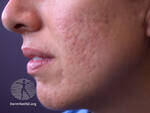Updates recommendations for benzoyl peroxide, topical retinoids, topical antibiotics, and oral doxycycline and oral isotretinoin as well as conditional recommendations for newer medications topical clascoterone, salicylic acid, and azelaic acid, as well as for oral minocycline, combined oral contraceptive pills, and spironolactone.
Scientists Attempt to Fight Acne With Skin Bacteria Engineered to Deliver Treatment
FightAcne.com Interview with:
Nastassia Knödlseder PhD (She/Her)
Postdoctoral Researcher
Department of Medicine and Life Sciences (MELIS)
Pompeu Fabra University in Barcelona

FightAcne.com: What is the background for this study?
Response: Cutibacterium acnes is the most abundant commensal of the human skin. It inhabits the pilosebaceous units of the hair follicles where it feeds from sebum. This niche environment is of great interest since it is located deep inside the dermis close to interesting dermatological targets.
Continue readingMore Education and Better Strategies Needed to Fight Acne in Transgender Individuals
FightAcne.com Interview with:
Howa Yeung, MD MSc | He/him
Assistant Professor of Dermatology
Emory University School of Medicine

FightAcne.com: What is the background for this study?
Response: Acne is common in transgender and gender diverse individuals who receive gender-affirming hormone therapy – a health disparity population that is understudied in health research. We aimed to explore the impact of acne and identify practice gaps in acne treatment in transgender and gender diverse individuals.
FightAcne.com: What are the main findings?
Response: Acne led to experiences of rejection and discrimination, worsened body dissatisfaction, and led to social avoidance. Transgender women reported acne interfering with feminine gender expression. Transgender men often normalized acne development, sometimes positively as an early sign of testosterone action. Many tried over-the-counter treatments and sought advice from physicians, peers, online forums, and social media.
Barriers to acne treatments included cost, lack of multidisciplinary care, mistrust toward the health care system, and lack of transgender-specific acne care education. Isotretinoin treatment required navigation of potential mental health adverse effects and patient discomfort with contraceptive and pregnancy testing requirements.
Double Blind Study Finds Spironolactone Effective in Fighting Acne
FightAcne.com Interview with:
Prof. Miriam Santer
Professor of Primary Care Research
Primary Care Research Centre
School of Primary Care, Population Sciences and Medical Education (PPM)
Faculty of Medicine
University of Southampton, Southampton

FightAcne.com: What is the background for this study?
Response: Spironolactone has been used for the treatment of acne in women for many years, but with surprisingly little evidence from randomised trials regarding its effectiveness. This lack of evidence meant that, although it was in some national prescribing guidelines, it wasn’t in most guidelines, leading to uncertainty amongst prescribers and frustration for women trying to access this treatment.
Continue readingColorism Can Lead to Use of Potentially Harmful Skin Lightening Products
FightAcne.com Interview with:
Roopal V Kundu, MD
Associate Dean for Admissions
Jacob R. Suker, MD, Professor of Medical Education
Professor of Dermatology (Medical Dermatology and Medical Education

FightAcne.com: What is the background for this study? What is ‘colorism”
Response: The study stemmed from patient interactions in clinics where some patients were coming in requesting to lighten their skin. In trying to understand this better, we learned that colorism – a type of shadeism – in which people of a certain ethnic group are treated differently based on their darker skin color – was a psychosocial and socio-cultural factor effecting skin tone preferences.
Continue readingStudy Evaluates Effect of a Biofilm Disrupting Acne Cream on Mild-to-Moderate Facial Acne
Jonathan S. Dosik, MD
Principal Investigator
TKL Research, Inc.
Fair Lawn, New Jersey

FightAcne.com: What is the background for this study?
Response: Bacterial biofilms are communities of bacteria that adhere to a wide variety of surfaces, held together by polymer matrices composed of polysaccharides, secreted proteins, and extracellular DNA. Biofilms may penetrate into the sebum and act as an adhesive, promoting formation of microcomedones. On the skin, bacteria adhere to the surface of the pilosebaceous unit, secreting a protective physical polysaccharide barrier which provides resistance to antimicrobial therapies. Resistance to conventional antimicrobial treatment is not only due to the physical barrier created by the rapidly established biofilm, but also the expression of hundreds of new proteins. These proteins facilitate biofilm development by enabling bacterial surface attachment as well as clustering and secretion of extracellular polysaccharides.
Next Science, LLC. has developed acne cream products with formulations based on a material science approach which target both the biofilm and the bacteria entrenched within. This novel biofilm eradicating technology attacks biofilms in three ways:
- Breaks the ionic bridges that hold the biofilm together,
- Solubilizes the individual polymers, exposing the bacteria,
- Directly kills bacteria by cell lysis.
Effects of Acne and Acne Scarring Can Last Decades
FightAcne.com Interview with:
Jerry Tan, MD
Western University Canada
Schulich School of Medicine and Dentistry
Windsor, Ontario, Canada

FightAcne.com: What is the background for this study? What are the main findings?
Response: Acne was personified as an unwanted intruder responsible for negative self-image and emotional impairment
FightAcne.com: What should readers take away from your report?
Response: The burden of acne can extend across long durations of life (adolescence to adulthood),

With acne scarring, this adverse impact persists along with a expressions of resignation and acceptance.
Disclosures: Advisor, consultant, speaker and/or trialist for Bausch, Boots Walgreens, Cipher, Cutera, Galderma, L’Oreal, Pfizer, Novartis, Sun
Citation:
Tan J, Chavda R, Leclerc M, Dréno B. Projective Personification Approach to the Experience of People With Acne and Acne Scarring—Expressing the Unspoken. JAMA Dermatol. Published online July 20, 2022. doi:10.1001/jamadermatol.2022.2742
[last-modified]
The information on FightAcne.com is provided for educational purposes only, and is in no way intended to diagnose, cure, or treat any medical or other condition. Always seek the advice of your physician or other qualified health and ask your doctor any questions you may have regarding a medical condition. In addition to all other limitations and disclaimers in this agreement, service provider and its third party providers disclaim any liability or loss in connection with the content provided on this website.
Acne Scars: Trial Tests Microneedling With Insulin and Vitamin C
FightAcne.com Interview with:
Mohamed L. Elsaie, MD
Senator at the Egyptian Senate
Professor of Dermatology, NRC, Egypt
Fellow of the University of Miami; USA

FightAcne.com: What is the background for this study?
Response: Post acne scars following sebaceous injury and abnormal wound healing during the course of acne is a prevalent and challenging to treat condition To evaluate microneedling by dermapen with topical vitamin C versus microneedling with topical insulin in treating atrophic post-acne scars.
A split-face comparative study included 30 subjects with atrophic post-acne scars. Human insulin was topically applied to the left side of the face and on the right side, vitamin C serum was applied.
Spironolactone for Acne: Study Evaluates Risk of Cancer
FightAcne.com Interview with:
John S. Barbieri, M.D., M.B.A.
Director, Advanced Acne Therapeutics Clinic
Department of Dermatology
Brigham and Women’s Hospital

FightAcne.com: What is the background for this study?
Response: While spironolactone is an effective treatment for women with acne that can potentially reduce our reliance on oral antibiotics, concerns have been raised regarding whether spironolactone may be associated with increased risk of cancer, such as breast cancer. As a result, we performed a systematic review and meta-analysis to better understand whether spironolactone use is associated with increased cancer risk.
Adult Women Describe Impact of Acne on Their Personal and Professional Lives
FightAcne.com Interview with:
John S. Barbieri, M.D., M.B.A.
University of Pennsylvania Perelman School of Medicine
Philadelphia
Now practicing at: Brigham and Women’s Hospital

FightAcne.com: What is the background for this study?
Response: Nearly 50% of women experience acne in their 20s and 35% experience acne in their 30s. While several qualitative studies have examined acne in adolescence, the lived experience of adult female acne has not been explored in detail.
As a result, we conducted a series of semi-structured interviews among 50 adult women with acne to examine the lived experience of adult acne and its treatment.
